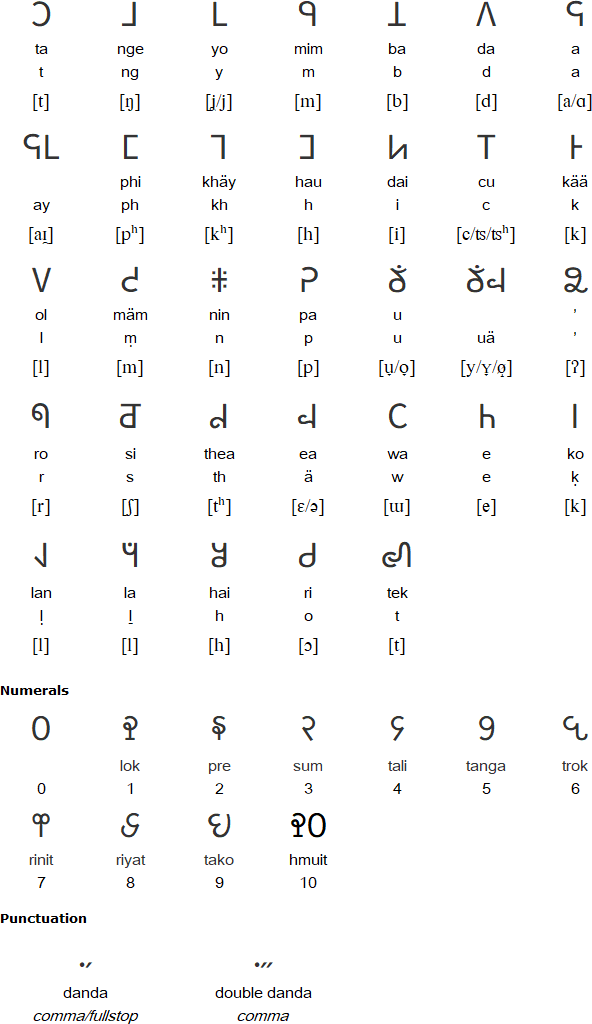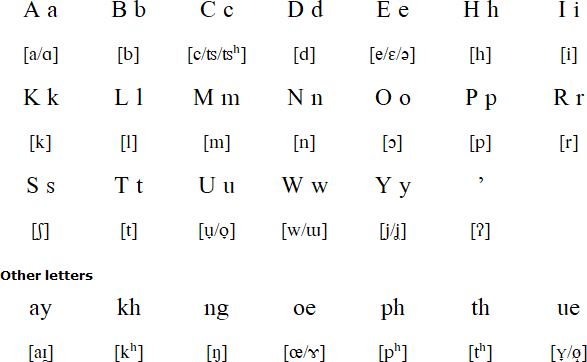Mro is a Tibeto-Burman language spoken by about 22,000 people mainly in Bandarban District of the Chittagong Hill Tracts in Bangladesh. It is also spoken in Sittwe (Akiab) in Rakhine State in Burma. Mro speakers live mainly in forest areas of Lama, Ruma, Alikaram and Thanchi near Chimbuk Mountain of Bandarban District. A small number also live in Rangamati Hill District.
The language is also known as Mru, which means 'human', and the people who speak it called themselves Mro-cha ('human beings'). Other tribes in the areas where the Mro live call them Murong ('strangers').
The Mro alphabet was created during the 1980s by Menlay Murang, or Manley Mro, a Mro who believed the creation of the alphabet was a redemption for a catastrophe told in Mro legend. The legend talks of the god Turai writing down a script and religion for the Mro people in a book and giving it to a cow to deliver. Unfortunately the cow became hungry on the long journey to earth and ate the book. Thus knowledge of the script was lost.
Around 80% of the Mro are thought to be literate in their own script, and it is taught in schools for the first 3 grades of primary education.


Download alphabet charts for Mro (Excel)

Näshai wäi mang cäläk ... Nämi näshai kä pram äyuk mä ... Klängpä yuk mä ämang tuän khop khop pä ... Näshai khokphakruäw kä läng shrin kambor khoa tped prang ... Längshinkambor näshai khokpha wäi tsham kheʼ kä äkar mi karshe tek lämi ang ing käng angingkäng khäbäd ... Ang ing käng
Information provided by Wolfram Siegel
Information about Mro
http://en.wikipedia.org/wiki/Mru_language
http://www.ethnologue.com/language/mro
http://scriptsource.org/cms/scripts/page.php?item_id=script_detail&key=Mroo
http://std.dkuug.dk/jtc1/sc2/wg2/docs/n3589.pdf
Mro font
http://phjamr.github.io/mro.html
Arakanese, Balti, Chocha Ngacha, Drung, Hajong, Hmar, Jingpho, Lepcha, Lhao Vo, Lhomi, Magar, Manipuri, Mro, Naxi, Newar, Pahari, Tangkhul Naga, Tujia, Yolmo
A-chik Tokbirim, Adinkra, ADLaM, Armenian, Avestan, Avoiuli, Bactrian, Bassa (Vah), Beitha Kukju, Beria (Zaghawa), Borama / Gadabuursi, Carian, Carpathian Basin Rovas, Chinuk pipa, Chisoi, Coorgi-Cox, Coptic, Cyrillic, Dalecarlian runes, Elbasan, Etruscan, Faliscan, Fox, Galik, Georgian (Asomtavruli), Georgian (Nuskhuri), Georgian (Mkhedruli), Glagolitic, Global Alphabet, Gothic, Greek, Hurûf-ı munfasıla, Irish (Uncial), Kaddare, Kayah Li, Khatt-i-Badíʼ, Khazarian Rovas, Koch, Korean, Latin, Lepontic, Luo Lakeside Script, Lycian, Lydian, Manchu, Mandaic, Mandombe, Marsiliana, Medefaidrin, Messapic, Mongolian, Mro, Mundari Bani, Nag Chiki, Naasioi Otomaung, N'Ko, North Picene, Novo Tupi, Nyiakeng Puachue Hmong, Odùduwà, Ogham, Old Church Slavonic, Oirat Clear Script, Ol Chiki (Ol Cemet' / Santali), Old Italic, Old Nubian, Old Permic, Ol Onal, Orkhon, Osage, Oscan, Osmanya (Somali), Pau Cin Hau, Phrygian, Pollard script, Runic, Székely-Hungarian Rovás (Hungarian Runes), South Picene, Sutton SignWriting, Sunuwar, Tai Viet, Tangsa, Todhri, Toto, Umbrian, (Old) Uyghur, Wancho, Yezidi, Zoulai
Page last modified: 07.08.24
[top]
You can support this site by Buying Me A Coffee, and if you like what you see on this page, you can use the buttons below to share it with people you know.

If you like this site and find it useful, you can support it by making a donation via PayPal or Patreon, or by contributing in other ways. Omniglot is how I make my living.
Note: all links on this site to Amazon.com, Amazon.co.uk
and Amazon.fr
are affiliate links. This means I earn a commission if you click on any of them and buy something. So by clicking on these links you can help to support this site.
[top]